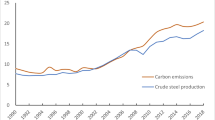Abstract
Since the iron and steel sector contributes considerably to industrial CO2 emissions, it is important to identify the underlying factors driving steel demand. Using a panel dataset, this paper examines the interrelation of steel demand with GDP and its composition, in particular the investment share since investment goods can be expected to be particularly steel-intensive. Our analysis confirms that there seems to be an increase of steel demand in an initial stage of economic development and a decline after economies have reached a certain level of per capita income. Moreover, we find some evidence that carbon leakage does not seem to play a role in the steel sector.


Similar content being viewed by others
Notes
Apparent steel use measures a country's crude steel production plus net crude steel exports."
However, there still might be an endogeneity problem, since apparent steel use per capita could be correlated with country-specific effects.
There is an ongoing research project at World Steel Association to calculate such data.
The coefficients of per capita income and per capita income squared determine at which income level steel consumption reaches its maximum.
In the case of advanced economies, the dummy is 0 for the whole sample period.
Running the regression for developing and advanced economies separately, leads to similar results
According to calculations of Bussiere et al. (2011, p. 35), the import content of total investment tends to be larger in developing countries.
The energy consumption per ton of steel in China was about 15–20 % higher than international best practice (Zhang et al. 2012).
References
Aichele R, Felbermayr G (2012) The carbon footprint of nations. J Environ Econ Manag 63(3):336–354
Bussiere, M., Callegari, G., Ghironi, F., Sestieri, G. and N. Yamano (2011), Estimating trade elasticities: demand composition and the trade collapse of 2008-09. NBER Working Paper 17712. Cambridge MA, NBER
Clark, C. (1940), The conditions of economic progress. London: MacMillan & Co. Ltd. 3rd edn., largely rewritten 1957.
Crompton P (1999) Forecasting steel consumption in South-East Asia. Res Policy 25(2):111–123
Crompton P (2000) Future trends in Japanese steel consumption. Res Policy 26:103–114
Eskeland GS, Harrison AE (2003) Moving to greener pastures? Multinationals and the pollution haven hypothesis. J Dev Econ 70(1):1–23
Fisher, AGB (1935) Production, primary, secondary and tertiary. In: The economic record, 15.6 (1939), 24-38.
Manderson E, Kneller R (2012) Environmental regulations, outward FDI and heterogeneous firms: are countries used as pollution havens? Environ Resour Econ 51(3):317–352
Molajoni P and Szewczyk A (2012) Indirect trade in steel: definitions, methodology and applications. Working paper, World Steel Association
RWI (2008) Die Klimavorsorgeverpflichtung der deutschen Wirtschaft—Monitoringbericht 2005-2007. RWI Projektberichte
Tcha M, Takashina G (2002) Is world metal consumption in disarray? Res Policy 28(1):61–74
Tilton J (1990) World metal demand: trends and prospects. Resources for the Future, Washington DC
Wårrel, L. and A. Olsson (2009), Trends and development in the intensity of steel use: an econometric analysis. Paper presented at the 8th ICARD, June 23-26. 2009, in Skellefteå, Sweden.
Wårrel L (2014) Trends and developments in long-term steel demand—the intensity-of-use hypothesis revisited. Res Policy 39:134–143
Zhang B, Wang Z, Yin J, Su L (2012) CO2 emission reduction within Chinese iron & steel industry: practices, determinant and performance. J Clean Prod 33:167–178
Acknowledgments
We thank Christoph M. Schmidt for his valuable comments and suggestions.
Author information
Authors and Affiliations
Corresponding author
Rights and permissions
About this article
Cite this article
Döhrn, R., Krätschell, K. Long-term trends in steel consumption. Miner Econ 27, 43–49 (2014). https://doi.org/10.1007/s13563-014-0046-8
Received:
Accepted:
Published:
Issue Date:
DOI: https://doi.org/10.1007/s13563-014-0046-8




